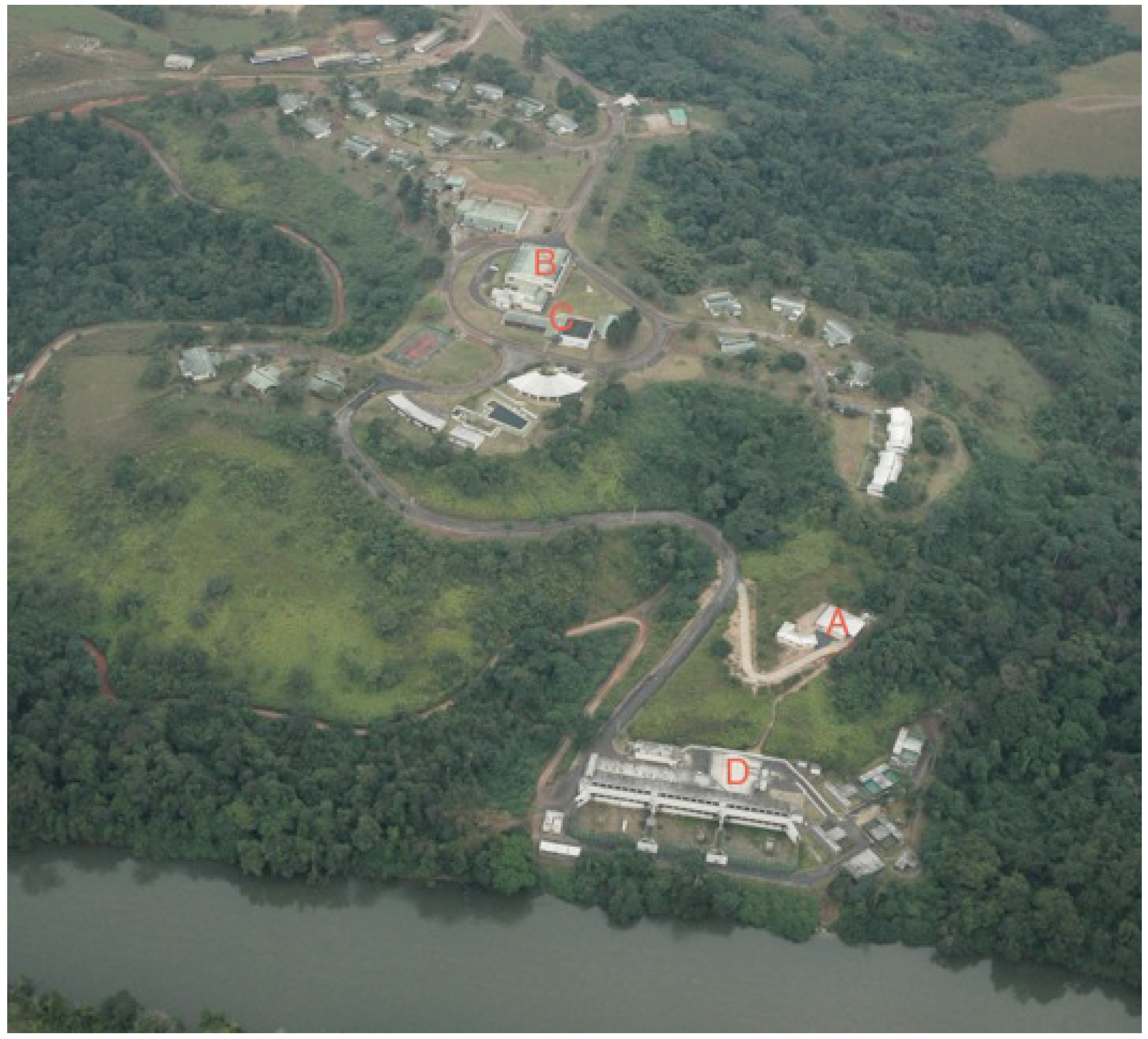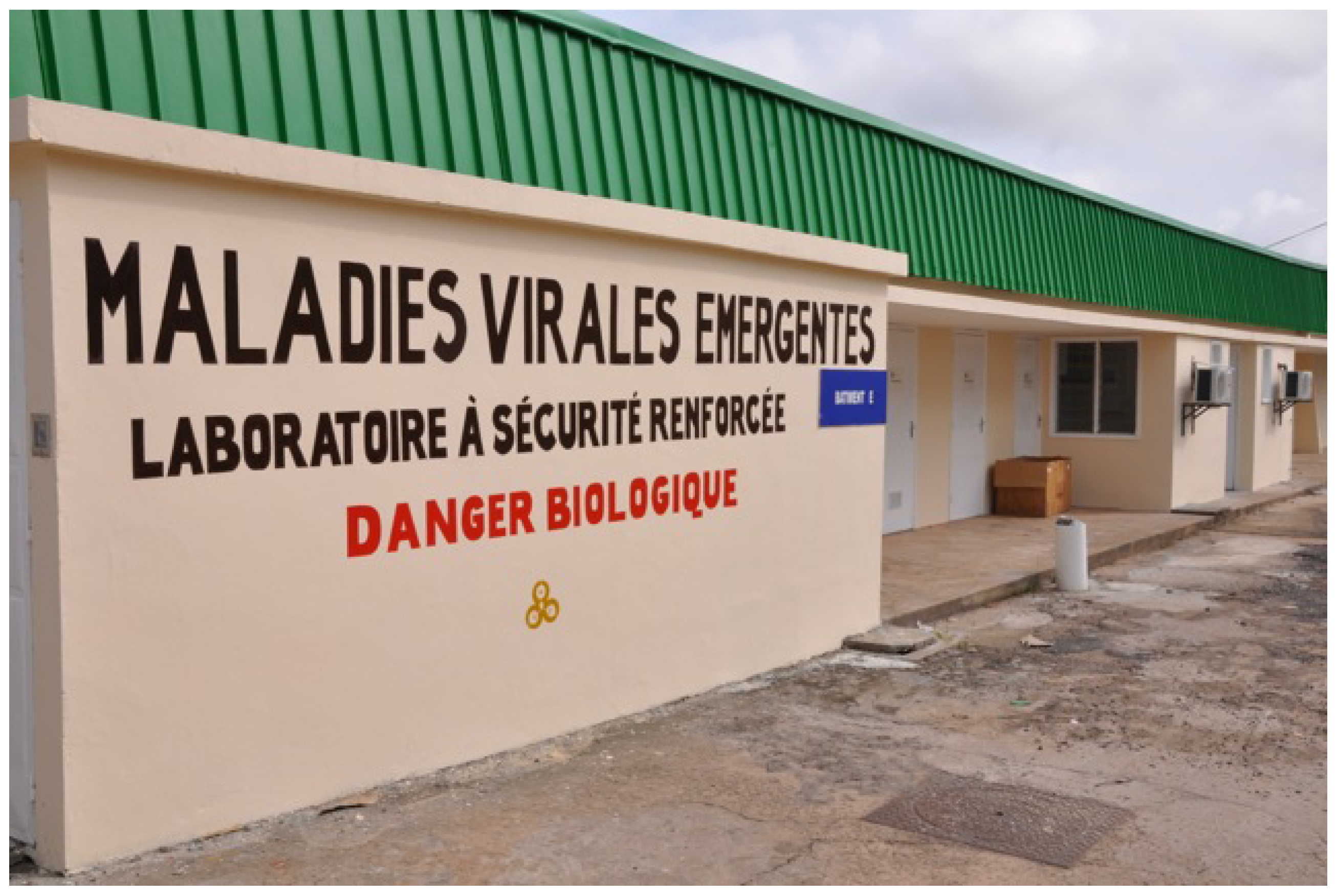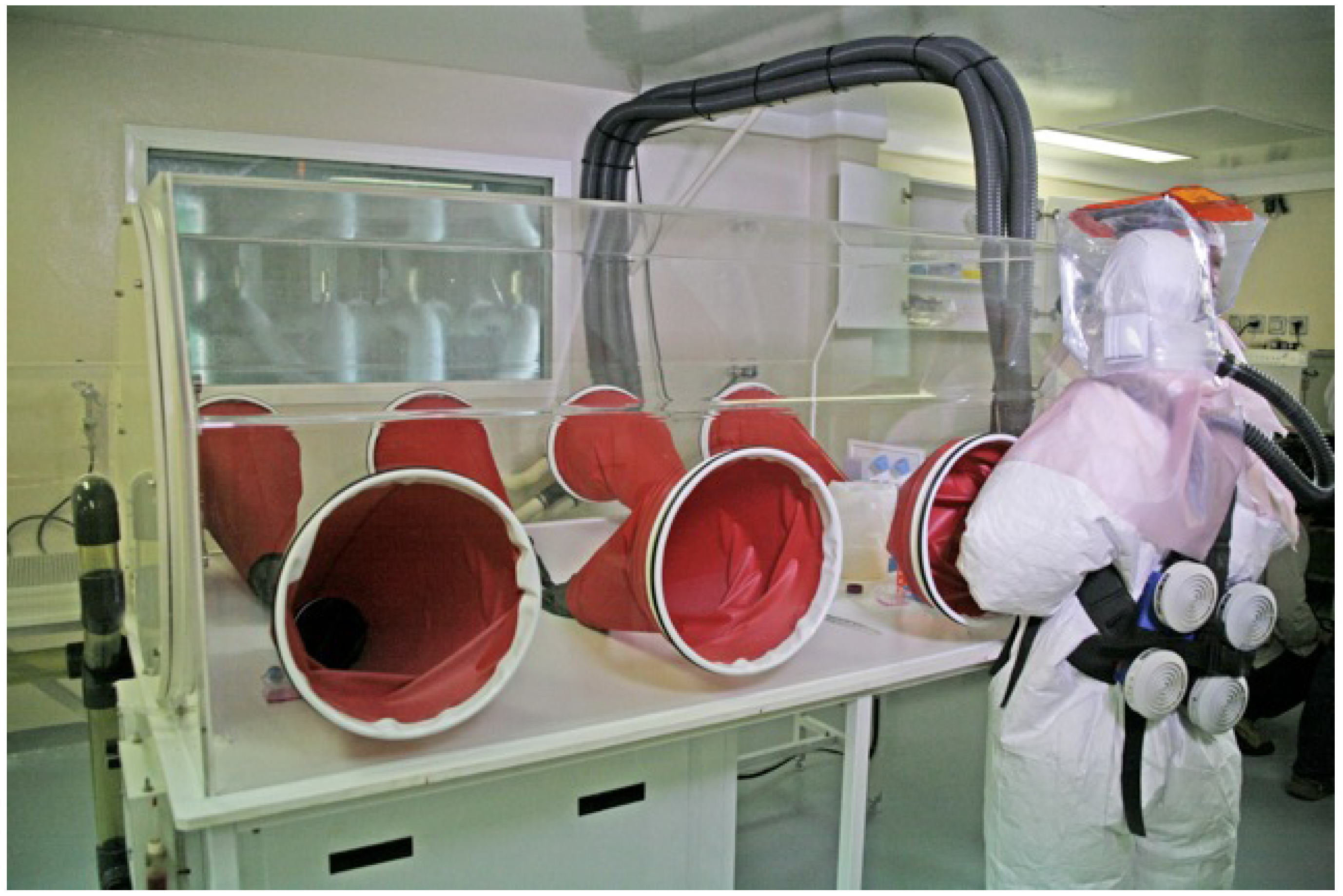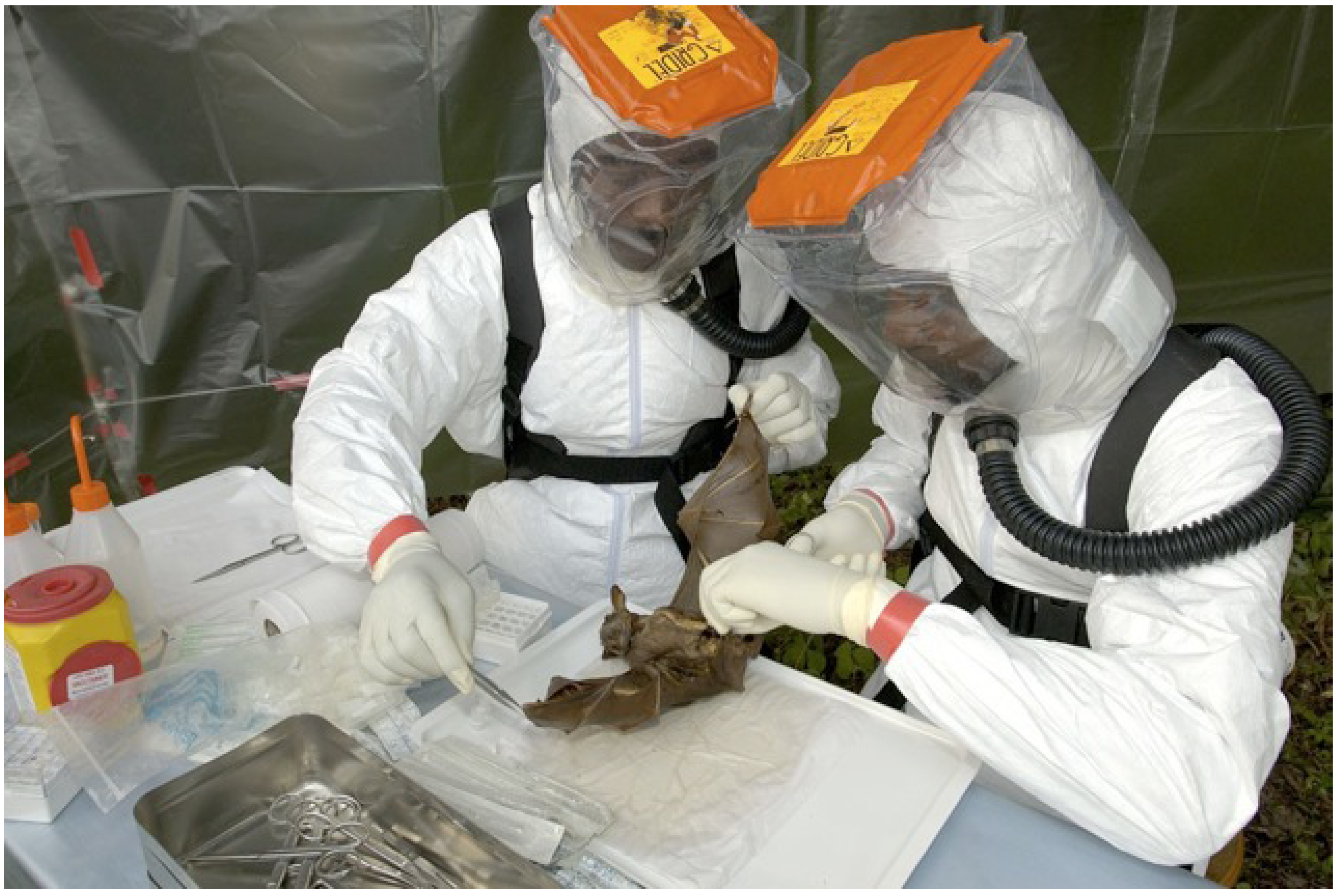Filovirus Research in Gabon and Equatorial Africa: The Experience of a Research Center in the Heart of Africa
Abstract
:1. Development of Research Facilities for the Study of Viral Hemorrhagic Fevers



2. Infrastucture
2.1. Facilities
2.2. Organization
2.3. Funding
3. Objectives: Training, Public Health Support, and Research
3.1. Training
3.2. Public Health Support through National, Regional, and International Partnerships
3.2.1. National Partnerships
3.2.2. Regional Partnerships
3.2.3. International Partnerships
3.3. Research from the Emerging Viral Disease Unit
3.3.1. Developing Tools and Methods for Virus Detection
3.3.2. Understanding Filovirus Natural History

3.3.3. Ebola Virus Disease Pathogenesis
3.3.4. Challenges of Conducting Filovirus Research in Gabon
| Family | Genus/Virus * | Origin/Country ** | Year | Host | Genetics/virus isolates *** |
|---|---|---|---|---|---|
| Filoviridae | Ebolavirus/Ebola virus **** | Mayibout 2/Gabon | 1996 | Human | +/+ |
| Ebolavirus/Ebola virus | Booué/Gabon | 1997 | Human | +/+ | |
| Ebolavirus/Ebola virus | Mendemba/Gabon | 2001 | Human | +/+ | |
| Ebolavirus/Ebola virus | Makokou/Gabon | 2002 | Human | +/+ | |
| Ebolavirus/Ebola virus | Ilahounéné/Gabon | 2002 | Human | +/+ | |
| Ebolavirus/Ebola virus | Ekatangaye/Gabon | 2002 | Human | +/+ | |
| Ebolavirus/Ebola virus | Ekata/Gabon | 2001 | Human | +/+ | |
| Ebolavirus/Ebola virus | Olloba/Gabon | 2001 | Human | +/+ | |
| Ebolavirus/Ebola virus | Mbomo/Gabon | 2002 | Human | +/+ | |
| Ebolavirus/Ebola virus | Yembelengoye/Gabon | 2003 | Human | +/+ | |
| Ebolavirus/Ebola virus | Mvoula/RC * | 2003 | Human | +/+ | |
| Ebolavirus/Ebola virus | Mbandza/RC | 2003 | Human | +/+ | |
| Ebolavirus/Ebola virus | Etoumbi/RC | 2005 | Human | +/+ | |
| Ebolavirus/Ebola virus | Luebo/RDC | 2007 | Human | +/+ | |
| Ebolavirus/Ebola virus | Luebo/RDC | 2008 | Human | +/+ | |
| Ebolavirus/Ebola virus | Ekata/Gabon | 2002 | Bat | +/- | |
| Ebolavirus/Ebola virus | /Gabon | 2002 | Chimp | +/- | |
| Ebolavirus/Ebola virus | /Gabon | 2002 | Gorilla | +/- | |
| Ebolavirus/Ebola virus | /Gabon | 2002 | Duiker | +/- | |
| Ebolavirus/Ebola virus | /Gabon | 2003 | Chimp | +/- | |
| Ebolavirus/Ebola virus | /Gabon | 2003 | Gorilla | +/- | |
| Ebolavirus/Ebola virus | /RC | 2005 | Chimp | +/- | |
| Ebolavirus/Ebola virus | /RC | 2005 | Gorilla | +/- | |
| Marburgvirus/Marburg virus | Lambaréné/Gabon | 2005 | Bat | +/- | |
| Marburgvirus/Marburg virus | Tchibanga/Gabon | 2006 | Bat | +/- | |
| Marburgvirus/Marburg virus | Makokou/Gabon | 2009 | Bat | +/- | |
| Togaviridae | Alphavirus/Chikungunya virus | Malabo/EG | 2007 | Human | +/- |
| Alphavirus/Chikungunya virus | Libreville/Gabon | 2007–2008 | Human | +/+ | |
| Alphavirus/Chikungunya virus | Oyem/Gabon | 2007 | Human | +/+ | |
| Alphavirus/Chikungunya virus | Lambaréné/Gabon | 2008–2009 | Human | +/+ | |
| Alphavirus/Chikungunya virus | Ndjolé/Gabon | 2008 | Human | +/+ | |
| Alphavirus/Chikungunya virus | Lastourville/Gabon | 2007 | Human | +/+ | |
| Alphavirus/Chikungunya virus | Franceville/Gabon | 2010 | Human | +/+ | |
| Alphavirus/Chikungunya virus | /Gabon | 2007–2010 | Human | +/+ | |
| Alphavirus/Chikungunya virus | Brazzaville/RC | 2011 | Human | +/+ | |
| Alphavirus/Chikungunya virus | /RDC | 2010–2011 | Human | +/- | |
| Alphavirus/Chikungunya virus | /Gabon | 2007–2010 | Mosquito | +/- | |
| Flaviviridae | Flavivirus/Dengue virus 2 | Libreville/Gabon | 20072008 | Human | +/+ |
| Flavivirus/Dengue virus 2 | Oyem/Gabon | 2007 | Human | +/+ | |
| Flavivirus/Dengue virus 2 | Lambaréné/Gabon | 2008–2009 | Human | +/+ | |
| Flavivirus/Dengue virus 2 | Ndjolé/Gabon | 2008 | Human | +/+ | |
| Flavivirus/Dengue virus 2 | Lastourville/Gabon | 2007 | Human | +/+ | |
| Flavivirus/Dengue virus 2 | Franceville/Gabon | 2010 | Human | +/+ | |
| Flavivirus/Dengue virus 2 | /RDC | 2011 | Human | +/- | |
| Flavivirus/Dengue virus 2 | /Gabon | 2007–2010 | Mosquito | +/- | |
| Flavivirus/Dengue virus 1 | Libreville/Gabon | 2007–2008 | Human | +/+ | |
| Flavivirus/Dengue virus 1 | Lambaréné/Gabon | 2008–2009 | Human | +/+ | |
| Flavivirus/Dengue virus 1 | Franceville/Gabon | 2010 | Human | +/+ | |
| Flavivirus/Dengue virus 1 | /RDC | 2011 | Human | +/- | |
| Flavivirus/Dengue virus 3 | Franceville/Gabon | 2010 | Human | +/+ | |
| Flaviviridae | Flavivirus/Zika virus | Libreville/Gabon | 2007 | Human/Mosquito | +/- |
| Flavivirus/Wesselsbron virus | /Gabon | 2010 | Duiker | +/- | |
| Flavivirus/Spondweni virus | /Gabon | 2010 | Duiker | +/- | |
| Bunyaviridae | Nairovirus/CCHFV | /RDC | 2009 | Human | +/- |
| Phlebovirus/RVFV * | /Gabon | 2011 | Tick | +/- | |
| Picornaviridae | Enterovirus/PV1 | Pointe Noire/RC | 2010 | Human | +/+ |
| Rhinovirus/UT ***** | /Gabon | 2010–2012 | Human | +/- | |
| Parechovirus/UT | /Gabon | 2010–2012 | Human | +/- | |
| Parechovirus/UT | /Gabon | 2010–2012 | Human | +/- | |
| Enterovirus/UT | /Gabon | 2011 | Monkeys | +/- | |
| Coronaviridae | Coronavirus/HCoV NL63 | /Gabon | 2010–2012 | Human | +/- |
| Coronavirus/HCoV HKU1 | /Gabon | 2010–2012 | Human | +/- | |
| Coronavirus/HCoV OC43 | /Gabon | 2010–2012 | Human | +/- | |
| Coronavirus/HCoV 229E | /Gabon | 2010–2012 | Human | +/- | |
| Coronavirus/UT | /Gabon | 2005–2009 | Bat | +/- | |
| Paramyxoviridae | Pneumovirus/hRSV | /Gabon | 2010–2012 | Human | +/- |
| Respirovirus/PIV 1 | /Gabon | 2010–2012 | Human | +/- | |
| Rubulavirus/PIV 2 | /Gabon | 2010–2012 | Human | +/- | |
| Respirovirus/PIV 3 | /Gabon | 2010–2012 | Human | +/- | |
| Rubulavirus/PIV 4 | /Gabon | 2010–2012 | Human | +/- | |
| Metapneumovirus/hMPV | /Gabon | 2010–2012 | Human | +/- | |
| Rubulavirus/UT | /Gabon | 2005–2009 | Bat | +/- | |
| Morbillivirus/UT | /Gabon | 2005–2009 | Bat | +/- | |
| Henipavirus/UT | /Gabon | 2005–2009 | Bat | +/- | |
| Orthomyxoviridae | Influenzavirus A/FLUAV H1N1 | /Gabon | 2010–2012 | Human | +/- |
| Influenzavirus A | /Gabon | 2010–2012 | Human | +/- | |
| Influenzavirus B | /Gabon | 2010–2012 | Human | +/- | |
| Adenoviridae | Adenovirus/UT | /Gabon | 2010–2012 | Human | +/- |
| Reoviridae | Rotavirus/UT | /Gabon | 2010–2012 | Human | +/- |
| Caliciviridae | Sapovirus/UT | /Gabon | 2010–2012 | Human | +/- |
| Norovirus/NoVG2/2 | /Gabon | 2010–2012 | Human | +/- | |
| Norovirus/NoV1/2 | /Gabon | 2010–2012 | Human | +/- | |
| Astroviridae | Astrovirus/Human astrovirus | /Gabon | 2010–2012 | Human | +/- |
| Herpesviridae | Simplexvirus/HSV1 & HSV2 | /Gabon | 2010–2012 | Human | +/- |
| Simplexvirus/HSV1 & HSV2 | /Gabon | 2010–2011 | Human | +/- | |
| Varicellovirus/VZV | /Gabon | 2010–2012 | Human | +/- | |
| Varicellovirus/VZV | /Gabon | 2010–2011 | Human | +/- | |
| Cytomegalovirus/CMV | /Gabon | 2010–2012 | Human | +/- | |
| Cytomegalovirus/CMV | /Gabon | 2010–2011 | Human | +/- | |
| Roseolovirus/HHV6 | /Gabon | 2010–2012 | Human | +/- |
4. Conclusions
Acknowledgements
Conflict of Interest
References
- Centre International der Recherches Médicales de Francewille. Available online: http://www.cirmf.org/en/cirmf/history (accessed on August 2012).
- Le Parc National de LA LOPE (CIRMF). Available online: http://carnetsdevoyages.jeanlou.fr/page134/page24/page24.html (accessed on August 2012).
- Leroy, E.M.; Kumulungui, B.; Pourrut, X.; Rouquet, P.; Hassanin, A.; Yaba, P.; Delicat, A.; Paweska, J.T.; Gonzalez, J.P.; Swanepoel, R. Fruit bats as reservoirs of Ebola virus. Nature 2005, 438, 575–576. [Google Scholar]
- Pourrut, X.; Delicat, A.; Rollin, P.E.; Ksiazek, T.G.; Gonzalez, J.P.; Leroy, E.M. Spatial and temporal patterns of Zaire ebolavirus antibody prevalence in the possible reservoir bat species. J. Infect. Dis. 2007, 196, S176–S183. [Google Scholar] [CrossRef]
- Towner, J.S.; Pourrut, X.; Albarino, C.G.; Nkogue, C.N.; Bird, B.H.; Grard, G.; Ksiazek, T.G.; Gonzalez, J.P.; Nichol, S.T.; Leroy, E.M. Marburg virus infection detected in a common African bat. PLoS One 2007, 2, e764. [Google Scholar] [CrossRef]
- Leroy, E.M.; Rouquet, P.; Formenty, P.; Souquière, S.; Kilbourne, A.; Froment, J.-M.; Bermejo, M.; Smit, S.; Karesh, W.; Swanepeol, R.; et al. Multiple Ebola virus transmission events and rapid decline of central african wildlife. Science 2004, 303, 387–390. [Google Scholar] [CrossRef]
- Wittmann, T.J.; Biek, R.; Hassanin, A.; Rouquet, P.; Reed, P.; Yaba, P.; Pourrut, X.; Real, L.A.; Gonzalez, J.P.; Leroy, E.M. Isolates of Zaire ebolavirus from wild apes reveal genetic lineage and recombinants. Proc. Natl. Acad. Sci. USA 2007, 104, 17123–17127. [Google Scholar]
- Leroy, E.M.; Epelboin, A.; Mondonge, V.; Pourrut, X.; Gonzalez, J.P.; Muyembe-Tamfum, J.J.; Formenty, P. Human Ebola outbreak resulting from direct exposure to fruit bats in Luebo, Democratic Republic of Congo, 2007. Vector Borne Zoonotic Dis. 2009, 6, 723–728. [Google Scholar]
- Baize, S.; Leroy, E.M.; Georges-Courbot, M.-C.; Capron, M.; Lansoud-Soukate, J.; Debré, P.; Fisher-Hoch, S.P.; McCormick, J.B.; Georges, A.G. Defective humoral responses and extensive intravascular apoptosis are associated with fatal outcome in Ebola virus-infected patients. Nature Med. 1999, 5, 423–426. [Google Scholar] [CrossRef]
- Baize, S.; Leroy, E.M.; Mavoungou, E.; Fisher-Hoch, S.P. Apoptosis in fatal Ebola infection. Does the virus toll the bell for the immune system ? Apoptosis 2000, 5, 5–7. [Google Scholar] [CrossRef]
- Wauquier, N.; Becquart, P.; Padilla, C.; Baize, S.; Leroy, E.M. Human fatal zaire Ebola virus infection is associated with an aberrant innate immunity and massive lymphocyte apoptosis. PLoS Neg. Trop. Dis. 2010, 4, e837. [Google Scholar] [CrossRef]
- Wauquier, N.; Padilla, C.; Becquart, P.; Leroy, E.; Vieillard, V. Association of KIR2DS1 and KIR2DS3 with fatal outcome in Ebola virus infection. Immunogenetics 2010, 62, 767–771. [Google Scholar] [CrossRef]
- Baize, S.; Leroy, E.M.; Georges, A.J.; Georges-Courbot, M.-C.; Capron, M.; Bedjabaga, I.; Mavoungou, E.; Lansoud-Soukate, J. Inflammatory responses in Ebola virus-infected patients. Clin. Exp. Immunol. 2001, 128, 163–168. [Google Scholar]
- Wauquier, N.; Becquart, P.; Nkoghe, D.; Padilla, C.; Ndjoyi-Mbiguino, A.; Leroy, E.M. The acute phase of Chikungunya virus infection in humans is associated with strong innate immunity and T CD8 cell activation. J. Infect. Dis. 2011, 204, 115–123. [Google Scholar] [CrossRef]
- Leroy, E.M.; Becquart, P.; Wauquier, N.; Baize, S. Evidence for Ebola virus superantigen activity. J. Virol. 2011, 85, 4041–4042. [Google Scholar] [CrossRef]
- Leroy, E.M.; Baize, S.; Volchkov, V.E.; Fisher-Hoch, S.P.; Georges-Courbot, M.-C.; Lansoud-Soukate, J.; Capron, M.; Debré, P.; McCormick, J.B.; Geoges, A.J. Human asymptomatic Ebola infection and strong inflammatory response. Lancet 2000, 355, 2210–2215. [Google Scholar]
- Leroy, E.M.; Baize, S.; Debré, P.; Lansoud-Soukate, J.; Mavoungou, E. Early immune responses accompanying human asymptomatic Ebola infections. Clin. Exp. Immunol. 2001, 124, 453–460. [Google Scholar] [CrossRef]
- Becquart, P.; Wauquier, N.; Mahlakoiv, T.; Nkoghe, D.; Padilla, C.; Souris, M.; Ollomo, B.; Gonzalez, J.P.; de Lamballerie, X.; Kazanji, M.; et al. High prevalence of both humoral and cellular immunity to Zaire ebolavirus among rural populations in Gabon. PLoS One 2010, 5, e9126. [Google Scholar]
- Caron, M.; Paupy, C.; Grard, G.; Becquart, P.; Mombo, I.; Nso, B.B.; Kassa, F.K.; Nkoghe, D.; Leroy, E.M. Recent introduction and rapid dissemination of Chikungunya virus and Dengue virus serotype 2 associated with human and mosquito co-infections in Gabon, Central Africa. Clin. Infect. Dis. 2012, 55, e45–e53. [Google Scholar] [CrossRef]
- Grard, G.; Drexler, J.F.; Fair, J.; Muyembe, J.J.; Wolfe, N.D.; Drosten, C.; Leroy, E.M. Re-emergence of Crimean-Congo hemorrhagic fever virus in Central Africa. PLoS Negl. Trop. Dis. 2011, 5, e1350. [Google Scholar] [CrossRef]
- Grard, G.; Drexler, J.F.; Lekana-Douki, S.; Caron, M.; Lukashev, A.; Nkoghe, D.; Gonzalez, J.P.; Drosten, C.; Leroy, E. Type 1 wild poliovirus and putative enterovirus 109 in an outbreak of acute flaccid paralysis in Congo, October-November 2010. Euro. Surveill. 2010, 15, 47. [Google Scholar]
- Leroy, E.M.; Nkoghe, D.; Ollomo, B.; Nze-Nkogue, C.; Becquart, P.; Grard, G.; Pourrut, X.; Charrel, R.; Moureau, G.; Ndjoyi-Mbiguino, A.; et al. Concurrent chikungunya and dengue virus infections during simultaneous outbreaks, Gabon, 2007. Emerg. Infect. Dis. 2009, 15, 591–593. [Google Scholar] [CrossRef]
© 2012 by the authors; licensee MDPI, Basel, Switzerland. This article is an open-access article distributed under the terms and conditions of the Creative Commons Attribution license (http://creativecommons.org/licenses/by/3.0/).
Share and Cite
Leroy, E.; Gonzalez, J.P. Filovirus Research in Gabon and Equatorial Africa: The Experience of a Research Center in the Heart of Africa. Viruses 2012, 4, 1592-1604. https://doi.org/10.3390/v4091592
Leroy E, Gonzalez JP. Filovirus Research in Gabon and Equatorial Africa: The Experience of a Research Center in the Heart of Africa. Viruses. 2012; 4(9):1592-1604. https://doi.org/10.3390/v4091592
Chicago/Turabian StyleLeroy, Eric, and Jean Paul Gonzalez. 2012. "Filovirus Research in Gabon and Equatorial Africa: The Experience of a Research Center in the Heart of Africa" Viruses 4, no. 9: 1592-1604. https://doi.org/10.3390/v4091592
APA StyleLeroy, E., & Gonzalez, J. P. (2012). Filovirus Research in Gabon and Equatorial Africa: The Experience of a Research Center in the Heart of Africa. Viruses, 4(9), 1592-1604. https://doi.org/10.3390/v4091592




